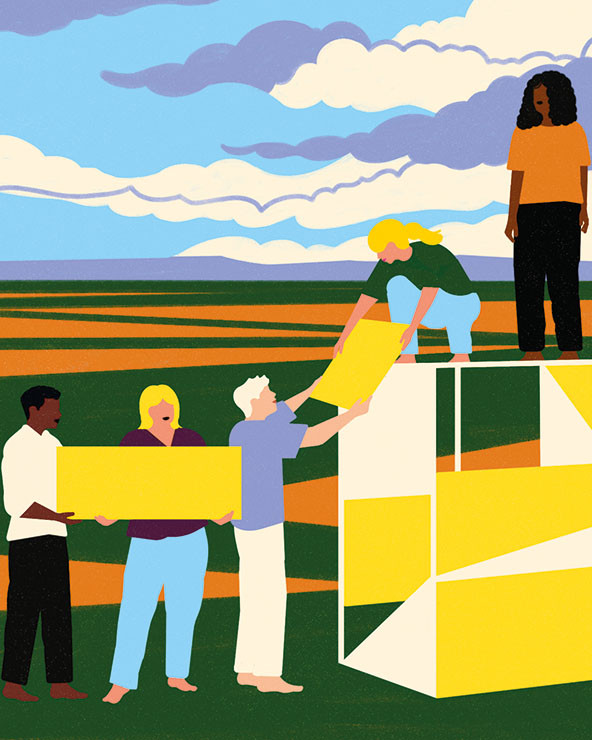
(Illustration by Andrea Mongia)
When Jamie Allison joined the Walter & Elise Haas Fund in 2018 as government director, she questioned, “The place have I landed? How do I lead right here? The place is the middle of gravity on this place?”
The Way forward for Philanthropy Is Belief-Primarily based
The trust-based philanthropy motion has grown in speedy time, however there are nonetheless primary misunderstandings about this strategy and its daring imaginative and prescient for a extra simply and democratic society. This complement illustrates what a trust-based strategy actually means, why it’s important to efficient philanthropy, and what shall be attainable if extra funders embrace it. Sponsored by the Belief-Primarily based Philanthropy Venture
Trustees had related questions as they wrestled with their needs to fund in deeper, bolder, and more practical methods. It was throughout this time––amid an government transition and a board shift from the household’s third to fourth generations––that the board of administrators launched into a means of reflection. Jennifer Haas, a fourth-generation board member and former board chair, remembers these days and the gradual transformations spurred by questions on tips on how to operationalize belief on the fund whereas contending with the group’s historical past and constructing for the longer term. At this time, at 71 years previous, the Walter & Elise Haas Sr. Fund is altering.
In recent times, we’ve engaged extra deeply with our program companions to establish moments after we function from a spot of behavior as an alternative of intentionality. With larger curiosity, we’ve been asking questions that lack easy solutions. Deeper listening has led to larger readability, together with about how we should work in another way to do our work nicely.
We acknowledged early that these processes may level our basis in new instructions. We requested ourselves, “Given our sources, information, and strengths, how can we be the simplest grant maker and changemaker in our neighborhood?” As our conversations continued, we arrived on the realization that we needed to grow to be a distinct sort of funder, embracing a full dedication to fairness and justice, rooted in belief.
Beneath the Grantmaking Floor
In 2020, COVID-19 and uprisings for racial justice introduced urgency to reexamining the basics of our work. Though we had been funding efforts that superior racial justice, we knew that our dedication needed to grow to be extra specific, and it felt essential to deepen our understanding of our grantmaking practices. As a part of this course of, trustees recognized 4 values to function guideposts for our work: household, chance, shared accountability, and belonging. We carried out a justice, fairness, range, and inclusion snapshot of the earlier 5 years of the fund’s grantmaking and a 15-year evaluation of the muse’s capital grantmaking.
The findings revealed that we had been making little to no capital investments in neighborhoods with giant populations of coloration, together with Oakland, the Mission, and Bayview-Hunters Level, regardless of being a basis with a historic deal with the Bay Space. In addition they confirmed that many of the basis’s giant endowment and capital grants had been going to giant, white-led cultural establishments and universities. To handle the disparities in our findings and to higher help our nonprofit companions, we launched three vital shifts in our grantmaking:
From silos to integration | We created an built-in portfolio referred to as Financial Properly-being to cut back the racial and gender wealth hole. Our built-in strategy addresses the interconnected nature of buildings, insurance policies, and practices to create a extra sustainable financial outlook for future generations. In breaking down silos between our grantmaking-program areas, we purpose to fulfill people and households the place they’re of their lives whereas remodeling the buildings that drive intergenerational poverty.
From signs to options | COVID-19 and the nationwide reckoning round systemic racism catalyzed new conversations concerning the effectiveness of philanthropy in instances of disaster. Whereas we’re pleased with how we confirmed as much as help our neighborhood throughout the tumult of the final three years, we at the moment are shifting to a extra proactive strategy that seeks options to issues earlier than they attain disaster ranges, together with funding organizations that work inside programs that create the cycle of poverty, from schooling and legal justice to authorities and the workforce.
From contributions to commitments |
Historically, philanthropic contributions have served as proof of help of a grantee’s mission. Their scope, period, and impression have been restricted, nonetheless. To help nonprofits extra successfully, we’re shifting to long-term partnerships characterised by shared accountability. Our new grantmaking strategy is to make bigger and longer common working grants, which nonprofits have recognized as vital to their sustainability. Establishing dedicated relationships with organizations supplies alternatives to construct trustworthy, trusting partnerships.
New Roles, New Prospects
The Haas Sr. Fund will not be the primary philanthropic group to acknowledge that some conventions associated to basis workers roles are outdated, such because the separation between program and administrative roles. As an extension of our shift from silos to integration, workers now works in matrixed groups that embrace program and administrative leaders working in partnership. For our largest grants, the fund’s director of administration conducts monetary due diligence and shares her report with the fund’s program lead and with the grantee. Grantees have expressed deep appreciation for relieving them of this burden and have begun to make use of the fund’s monetary diligence reviews internally. Outdated fashions form how grantee companions are supported, the place foundations spend the majority of their time, who leads, and extra.
As a part of our means of change, we’ve created workers roles that embrace a distinct view of the work and the buildings that help it.
In standard basis fashions, program workers are considered consultants and gatekeepers of sources. However on the fund, we’ve reoriented program work to deal with facilitative management: listening to neighborhood and welcoming neighborhood voices to affect our work. We embrace mutual studying and interdependence and consider neighborhood members and nonprofit leaders as consultants.
To assist us study in methods which might be grantee-partner targeted, we created the brand new workers place of strategist for justice, fairness, and studying. This position helps us undertake our grantees’ targets as our personal, monitor progress in partnership with our grantees, and share mutual studying with each other. Whereas grantmaking stays a operate of the Fund, it’s accomplished alongside different core work, together with organizing funders, convening grantees, sharing our strategy, and amplifying grantee knowledge.
To use a reparative lens to our grantmaking, we created a job power made up of workers members. With the duty power’s work as a information, our workers selected capital-grant suggestions to convey to the board. Employees working collectively on this cooperative, non-siloed, cross-program, and cross-functional approach was a distinct expertise for us. This strategy, which incorporates program leads; the grants supervisor; the strategist for justice, fairness, and studying; and the director of administration, amongst different workers, requires the identical belief and collaboration internally that we search to construct externally in {our relationships} with the neighborhood. The premium is on listening, compromise, sharing energy, and recognizing the knowledge of the collective.
One other space of change is our board dockets. As at different foundations, the docket grew to become a approach for program workers to reveal worth and experience; the longer and extra detailed their memos, the extra they felt they had been being revered and heard. However we realized that the other was the case: The memos had been indigestible. Extra essential, they had been signs of an educational, transactional strategy to grantmaking that prioritized course of over impression and lobbying the board over studying with them. Consequently, the docket has grow to be shorter, specializing in elevating main themes throughout points and grants. For workers and board members, this shift has clarified the intersections of our work in addition to our mission. The board transitioned from approving grants individually to approving them as a slate.
From Operationalizing to Reworking
We found that our grantmaking wanted an overhaul to higher align with our values
and provides our companions extra room to do their work, experiment, make investments, and win.
The Endeavor Fund
is our most vital philanthropic funding thus far. We awarded $3.5 million every to seven main nonprofit organizations over seven years, for a complete funding of $24.5 million, with the purpose of closing the racial and gender wealth hole. This multiyear initiative allows organizations led by folks of coloration to find out the perfect methods to deepen and develop to vary programs. We acknowledge and encourage the significance of investing in organizational capability, together with employee pay {and professional} growth.
Multiyear unrestricted grants are nonetheless not the norm.
Even for individuals who embrace a multiyear strategy, the common time period is 2 to a few years. Allison remembers being at a grant maker convention years in the past and watching the viewers members’ jaws drop when Pia Infante, a senior fellow on the Belief-Primarily based Philanthropy Venture, proposed that future grant durations be 10 years. “The shock for the viewers—myself included—tells me how vital it’s for funders to push ourselves and each other to share the concepts we’ve not but seen confirmed, particularly when our nonprofit companions are telling us what they should do their work.”
The conventions of establishment philanthropy—working in programmatic silos, imposing inflexible necessities that overly depend on transactions, written proposals, and reviews—as soon as provided predictability in our grantmaking cycles, consolation in our positional energy, and recyclable templates. They required much less of us and, in flip, resulted in much less impression and achievement. Our work as we speak requires us to be lively, engaged companions, and {our relationships} are rooted in belief, not management. Our accountability is to all our companions—our neighborhood, workers, and board.
Throughout our journey to operationalize belief, we proceed to study classes about what this work requires. Reasonably than a tough pivot, operationalizing belief might be an evolution. This transformation is nicely definitely worth the effort if our aim is to result in change and help our nonprofit companions to construct a extra equitable, trust-based future.
Assist SSIR’s protection of cross-sector options to world challenges.
Assist us additional the attain of progressive concepts. Donate as we speak.
Learn extra tales by Jamie Allison & Jennifer C. Haas.

